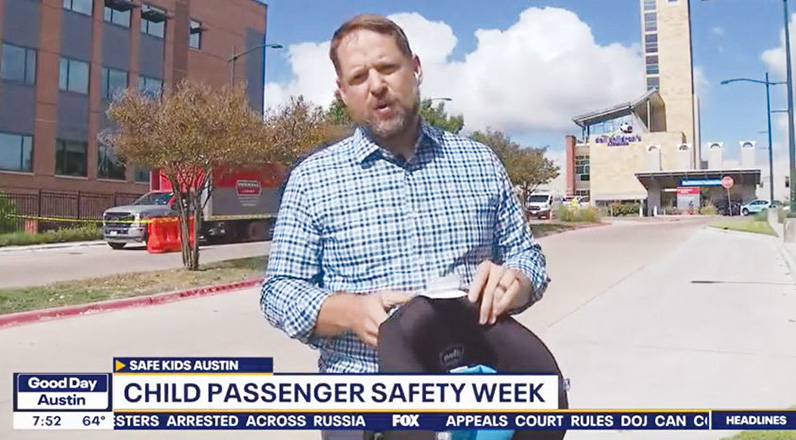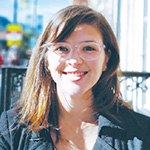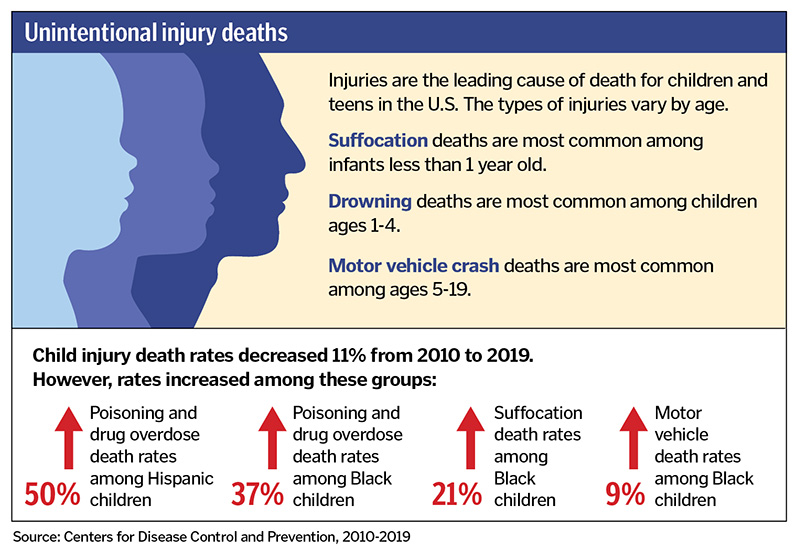
Stewart Williams, an injury prevention manager with Safe Kids Austin, led by Dell Children's Medical Center in Austin, Texas, appears on a local television program to talk about child passenger safety week. Safe Kids Austin partners with the station to do regular segments on child safety issues. Some ideas for the segments come from the injuries doctors see in the emergency room.
Stewart Williams and Raven Hood have a pretty good idea of why kids come into the emergency room at Ascension's Dell Children's Medical Center in Austin, Texas.
The pair talk with ER doctors. They see the statistics. Their job is to help keep kids from needing the emergency room in the first place, and that often involves educating the public.
Williams is an injury prevention manager and Hood is an injury prevention coordinator with Safe Kids Austin, which is led by Dell Children's. It is a coalition within Safe Kids Worldwide, a nonprofit that works to help families and communities keep kids from getting injured.

"It's the major severe injuries that we're trying to mitigate, so they're just an injury that needs a Band-Aid," says Williams. "That's our goal — to turn something that could be life-threatening or life-changing into something that's nothing more than a scratch."
Preventable injuries are the leading cause of death of kids in the United States, with 8,000 children dying because of a preventable injury in 2020, according to the Centers for Disease Control and Prevention. In Travis County, Texas, where Austin is located, accidental injuries were the leading cause of death in the years 2015-2019 for anyone up to age 44, with motor vehicle crashes at fault for the majority of those deaths, according to the Austin Public Health Department. Sleep-related injuries are the leading cause of deaths among infants age 1 month to 1 year, with most due to accidental suffocation from an unsafe sleep environment.
Surprising injury causes
While much of the coalition's time is spent mitigating these common injuries or causes of death — it often hosts car seat safety checks and educates parents about safe sleep practices — some issues come as a surprise.
Take, for example, ceiling fan injuries. Emergency room doctors at Dell Children's reported they saw children coming in with lacerations or depressed skull fractures from hitting the blades of a ceiling fan. Children were playing on bunk beds and getting hit, or parents were roughhousing and throwing their kids into the air. The low ceilings of some Austin houses added to the issue, says Williams. Through a partnership Safe Kids Austin has with a local TV station, Williams appeared on a regular safety segment and talked about ceiling fan safety.

Or take counterfeit car seats. Based on their training and exposure, Williams and Hood can easily spot seats that don't meet U.S. safety standards and may be made of cheap or shoddy materials. The injury prevention program at the hospital sometimes gives away safe car seats. But on a broader scale, Safe Kids Worldwide is working with Amazon to eliminate the sale of counterfeit seats among independent sellers on the platform, says Hood.
Or take the potential dangers of water bottle caps. The hospital medical director approached Williams and said doctors had removed the small white caps from several kids' throats or stomachs. Safe Kids Austin then did a television segment on the issue.
"There's an analogy of upstream-downstream thinking," says Williams, who has worked in child safety for 20 years. "We can spend all day pulling kids out of the water, but that doesn't change the problem. We need to go upstream and see why they are falling into the water in the first place. That's the concept."
A national effort
Safe Kids Worldwide was co-founded in 1988 by Dr. Marty Eichelberger and public relations consultant Herta Feely of the Children's National Hospital in Washington. Since its founding, the U.S. childhood death rate from unintentional injury has decreased by 61%, according to the organization.
Safe Kids Worldwide works with a network of more than 400 coalitions in the United States and has partners in more than 30 countries. Of those, about 45% are affiliated with a hospital or health system, about a quarter with local public health agencies, and the rest with local police and fire departments or nonprofit groups, says Daphne Greenlee, senior network manager for Safe Kids Worldwide.
"We look for a really strong agency that wants to take the lead but also bring the partners along to make sure that they're addressing those injuries in their community," she says. "So it can look very different in central Texas than it might in rural Montana, or in metro Atlanta."
Dell Children's is one of about 20 Catholic hospitals nationwide that lead a Safe Kids coalition. Others include Essentia Health — St. Mary's Medical Center in Duluth, Minnesota; Ascension Via Christi St. Francis in Wichita, Kansas; Franciscan Health Lafayette in Lafayette, Indiana; and Providence Santa Rosa Memorial Hospital in Santa Rosa, California.
Greenlee lauds Safe Kids Austin for its 30 years of work, and says it has a particularly strong trauma services team that focuses on injury prevention as a whole.
Safe Kids Austin has its own board of directors and works closely with the national group. One of the pillars of its work is advocacy, which includes trying to head off legislation that is potentially harmful to children and promoting legislation that could help them.
For years, Safe Kids coalitions in Texas fought against opponents of red-light cameras. "Ultimately, they won," says Williams. "And immediately, we saw an increase in trauma data related to red-light running."
Conversely, the coalitions succeeded in helping to pass legislation that raised age limit or height requirements for booster seats. However, they ultimately lost a push to keep children in rear-facing seats up to age 2.
Creativity and challenges
Hood and Williams say they're given a great deal of autonomy to be creative in their work so they can tackle new challenges. Safe Kids Austin partnered with drowning awareness groups Colin's Hope and Live Like Cati to provide loaner life jackets at the area's public parks. They partnered with Dell Children's to open a children's safety center inside the hospital that sells car seats, bicycle helmets, safe sleep items, and other products.
While they're given that creativity, they also have the responsibility to base what they do on best practices and research, which is why they rely on partners and the national group for support.
Their work is often a balance between educating an individual versus changing the situation for a larger population, Williams and Hood say.
"Parents are so busy — it blows my mind," says Hood, who came to Safe Kids Austin earlier this year after working in the adult injury prevention field. She's not a parent herself, so she tries to see things from a parent's perspective.
She says some parents have to be reminded to sit back and assess a situation, such as making sure a five-point harness on a car seat is properly secured. "Most parents want to do the best for their child," says Hood. "They're trying their hardest to do everything they can to keep their child safe. That's first and foremost. We are here to help and support them in any way we can."
